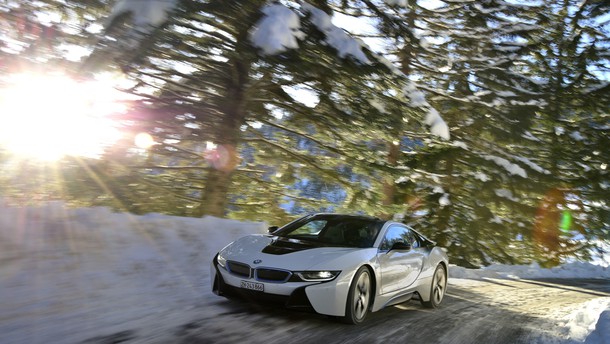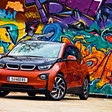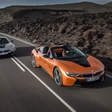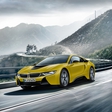
Well, let's admit it, we didn't search for snow. It actually came to us. And the BMW i8 is not entirely an electric car. In theory, it only drives about 37 kilometers on electricity and, in reality (at least during the winter), only around 25 kilometers, if you are more of an economical driver. This is a decent number for a plug-in hybrid sports car.
The snow caught us in the middle of Switzerland, when we were driving to a hotel which is at least as different from other hotels as the i8 is different from other plug-in hybrids. It is not difficult to find a five-star hotel in Switzerland – if you are a traditionalist. But this time, we were driving to a hotel that is much closer to nature. This is reflected in its Eco Luxury name, a title which describes all hotels that focus on the ecological aspect of offering comfort to guests, from energy consumption to environmental issues. The Whitepod Hotel, located on the cusp of the Alps, near the village of Les Cerniers, above Monthey, is an excellent showcase of environmentally-friendly comfort. Lying 1400 meters above sea level, 15 green (or white, during the winter) cupolas hide in a meadow beneath a forest. The idea is simple: the two-layered plastic walls, with air sandwiched between them, tacked onto a light frame, provides for great insulation. There is enough space in 40 square meters for all the necessary comforts, and the view of the town in the valley is phenomenal. The food (the restaurant is located in a wooden house in the middle of what would only generously be described as a "village") is of local origin (and they serve good local beer, too), all electrical devices are energy efficient, water comes from a nearby source, and you are warmed by wood from the local forest.

We drove the i8 from Zurich, and were glad that the Whitepod Hotel is quite far into the mountains, so that we were able to wind our way through the endless kilometers of mountain roads which abound in Switzerland. We got to know this unconventional Bavarian sports car quite well. Motorways? Only a few. The speed limit on motorways in Switzerland is so low, and road controls are so strict, that driving on motorways is simply a lost opportunity for pleasure.

Surprising to many car fans visiting Switzerland for the first time, this country is home to many premium and even sports cars. Well, the Swiss can afford them, that much is clear but, on the other hand, a car with a powerful engine that consumes a lot of energy is easier to buy if you know that it will use only a portion of its power and, most of the time, exist in a low-energy-consumption mode.

i8 has enough power to sprint to 100 km per hour in 4.4 s.
The BMW i8 is perfect for Swiss traffic. Well, as we have written above, the i8 is not entirely an electric car, it is a plug-in hybrid. However, its electric range suffices for most users. The car can drive 25 to 30 kilometers at a moderate tempo (in Switzerland this covers daily usage) in the warmer months, but when winter tires are on, and the temperature hits zero or below, the electric range is approximately five kilometers shorter. The 91-kilowatt electric motor drives the front wheels and has enough power, at full electric acceleration, to overcome the grip of the slightly narrower front wheels on wet asphalt (also due to winter tires), however, it has enough power to get the i8 to accelerate to 100 kilometers per hour in less than ten seconds, purely on electricity. In other words, it's not difficult to keep up with the daily road traffic purely with the electrically-driven i8 and, at the same time, enjoy the most important feature of electric cars: the sweet silence and already a noticeable boost, even at the minimum speed.
However, the 5 kWh lithium-ion battery will be empty long before, rather than after, you reach 25 kilometers, if you want to drive across mountain passes with electric power only. However, such an attempt is not even appropriate, at least not with a sportscar such as the BMW i8. An ascent from the shore of Lake Neuchatel – by the way, the Palafitte Hotel there not only offers a magnificent view of the lake, but also exquisite cuisine – towards the Alps easily reveals the character of a car like the i8, and it also offers other surprises.

However, it is no surprise that the i8 attracts the attention of the otherwise calm Swiss, who are used to expensive cars and, considering its design, this makes sense. The design is the result of a search for the best performance (including road handling) and minimum consumption – and fortunately, BMW did not forget that an attractive design is also one of the main attributes of a sports car. It's simple: if people don't turn their heads, the car is not a real sports car. But they do, even when you're still parked in the lot. Its scissor doors do require you to climb across the wide door sills; however, on the road, the i8 (especially in white or black) gives the impression that it has just driven in from the future. The interior is similar: instruments are digital (color LCD-display) and sufficiently futuristic, the seats are thin and the contours are familiar, so that those who are used to BMWs immediately feel at home. However, it's different enough for it to become immediately clear that this is not just another classic BMW.
The i8 is a 2+2 sports seat coupé which, despite its battery, weighs only 1,486 kilograms. The passenger cell (made mainly from CFRP, Carbon Fiber Reinforced Plastics), reinforced with carbon fiber, and extensive use of aluminum, as well as a small and light but powerful petrol engine, allow for this light mass.

The 1.5-liter 3-cylinder engine behind the back seats, which the turbocharger boosts up to 170 kW, is enough for a 4.4-second acceleration to 100 kilometers per hour. The engine is a real pearl. It's lively and, when the driver changes the gear shift of the 6-gear automatic gearbox to Sport mode, it's dynamic, high-performance athletic character really comes to life. BMW has demonstrated that small does not mean unnoticeable – of course, they used modern technology. The natural sound of the engine is complemented by the audio system of the car, and the sound system in the exhaust. Car purists find this quite intriguing but, after all, the result is what's important – and the result is superb. On the other hand, the i8 also has a quite reasonable fuel consumption – 2.1 liters (and 11.7 kWh of electricity) per 100 kilometers. The petrol engine is, as it should be, rear-wheel driven (with the Steptronic 6-speed automatic transmission in between), and the front wheels are driven by the electric motor, via a 2-speed transmission. The maximum power of the BMW i8 is 266 kilowatts.

When it comes to driving pleasure, the i8 can compete with most of the classic sporscars
From this standpoint, it cannot be compared to the cars from BMW's past, but they, in turn, cannot be compared with the i8, when it comes to the environment and modern technology. Not long ago, the environment and modern technology were very far apart compared to the situation today. This was demonstrated in the village of Rue that lies in the hills between Lakes Neuchâtel and Geneva. Right there, on the ground floor of a residential building, there stood a small garage, where we found a real treasure. Maurice Girard, a former local butcher, changed his amateur love of racing and old cars into a way of life. The sixty-year-old kindly unlocks the door and astonishes us. Two racing Procar BMW M1s are so low to the ground that they hardly reach our knees. One is even painted in an exotic white-green color. »I have this one to prevent me from racing with the other one,« says Maurice, as he shows us Alan Jones' original M1 Procar, which was driven by the Australian in 1980, after winning the Formula 1 World Championship, and taking second place in the Procar race. The Procar series was created in 1979 and 1980 by the head of BMW Motorsport, Jochen Neerpasch. The series pitted professional drivers from the Formula One World Championship, World Sports Car Championship and the European Touring Car Championship against one another, using identically-modified BMW M1 sports cars. The 350 kW race M1 still enjoys great esteem, and its series twin brother is actually the only real predecessor of the i8.

At the end of the 1970s and the beginning of the 1980s, they made 453 of them, and with 1300 kilograms and 200 kW, they were actually not that far from today's i8 – though, of course, the old 6-cylinder turbo with 5-speed transmission cannot show such a range of character as come to life in a car that combines a modern small turbo engine and an electric motor.
When you drive normally (in Comfort or ECO Pro mode, where the car's performance is slightly reduced), the i8 speeds up to 70 kilometers per hour only on electricity (unless the driver demands full acceleration) and, at faster speeds, it is driven by the electric motor, gas engine, or both combined. In Sport mode, the gas engine works constantly, with the electric motor mostly boosting the car's performance (energy recuperation also increasing at the same time), while in eDrive, only the electric motor takes the car up to 120 kilometers per hour.
When road friction is weak, the i8 uses the electric motor to transfer power to the surface, and vice versa – if the car automatically determines that, in the electric mode, the front wheels do not have sufficient grip to move, the petrol engine turns on and drives all four wheels.

And this came in quite handy for us. This year's Swiss winter was not particularly snowy but, when the road starts ascending towards a thousand meters above sea level and higher, and the winter decides to rear its head, even the otherwise fast and prudent winter service cannot help. We could have decided to wait for better weather, biding our time in one of the many local cheese dairies, but we did not choose to test drive on Swiss roads just to panic at the first few centimeters of snow. Could the i8 cope?
The answer is clear from the photos: quite easily, if the snow level is not so deep that it strands you in the middle. The i8 has 20-inch rims, but the tires (to lower consumption, of course) are not very wide: 215/45 R 20 at the front and 245/40/R20 at the back. The narrower winter tires offer another good feature: they do better on snow. The i8 did quite well through fresh and pretty deep snow, even when one might begin to think that it would be better to stop. However, when the surface beneath the wheels changed to a firmer, smoother packed snow, the i8 showed another side of its character: it turned into a drifting machine which was easily controllable, offered plenty of pleasure, and was accompanied by an appropriately-loud exhaust sound. The front and rear wheel drive combination is perfect to inspire confidence in the i8's driver to try out whatever they fancy. On dry tarmac, the i8 heads into the bends with precision, followed by a rapid acceleration towards the exit. This is accompanied by a slight slide of the back of the car, so that the front wheels follow the line more easily. The i8 reacts best on snow if the driver has firm control, and when the stability system is turned off. Yes, when it comes to pleasure in driving, the i8 can easily hold its own against most sports cars in its class. But the feeling as the driver calms down, and starts enjoying the view along the final kilometers of the road to the hotel, can be very, very different. The i8 does not bother lonely farms, peaceful forests or the view of the valley with its engine noise – its electric motor is barely noticeable at all, and the i8 practically becomes one with nature. And when it is necessary to walk from the car park to the hotel reception (this takes about 20 minutes, though the next morning, in the opposite direction, the path was more fun and quicker, as we went by sledge), the i8 stays in the car park, charging from an ordinary 220V power socket. Fast charging is not available for the i8. The fastest way to charge it is in two hours via a household Wallbox, or half an hour longer from a conventional socket with a 16A safety fuse (3.6kW power) – this is quite typical for the current plug-in hybrids. The trunk is spacious enough to store a flight bag and laptop case – to store more, you'd need to use the back seats (which are otherwise roomy enough for children). If you want to make good use of the hotel, then you need slightly more than what the i8's trunk has to offer. At least a good jacket and winter trousers, as well as boots which you can use to go snowshoeing across the nearby hills. Or skis (the hotel has its own piste) – but you need to rent them, since the i8 does not currently offer the possibility to install a roof rack. Too bad, because a sports car with a roof rack for skis has been "in" since the time that James Bond drove one across the Alps.

The hotel cupola is lit up by a fireplace, but we still did not have to give up the basic needs of civilization: wireless internet (which our smartphone app used to check what was happening with our i8, and to turn on the heating in the morning prior to our arrival), good food, drinks, and a sauna. It is great having it all, just in a slightly different way. The same goes for the i8: it offers practically everything that a sports car of this category should, but it offers it differently – and this is proof that sports pleasures do not require you to forget the environment.



